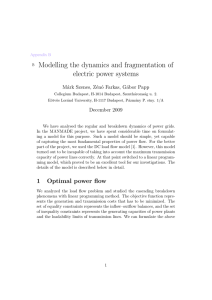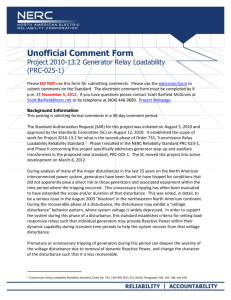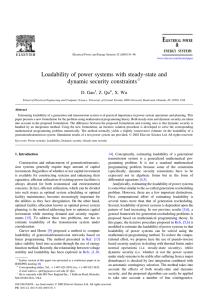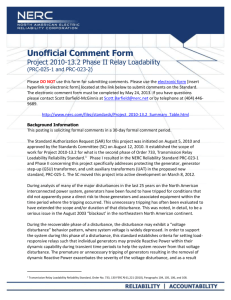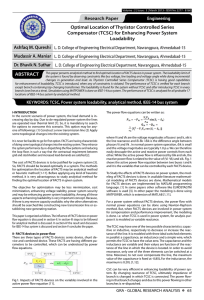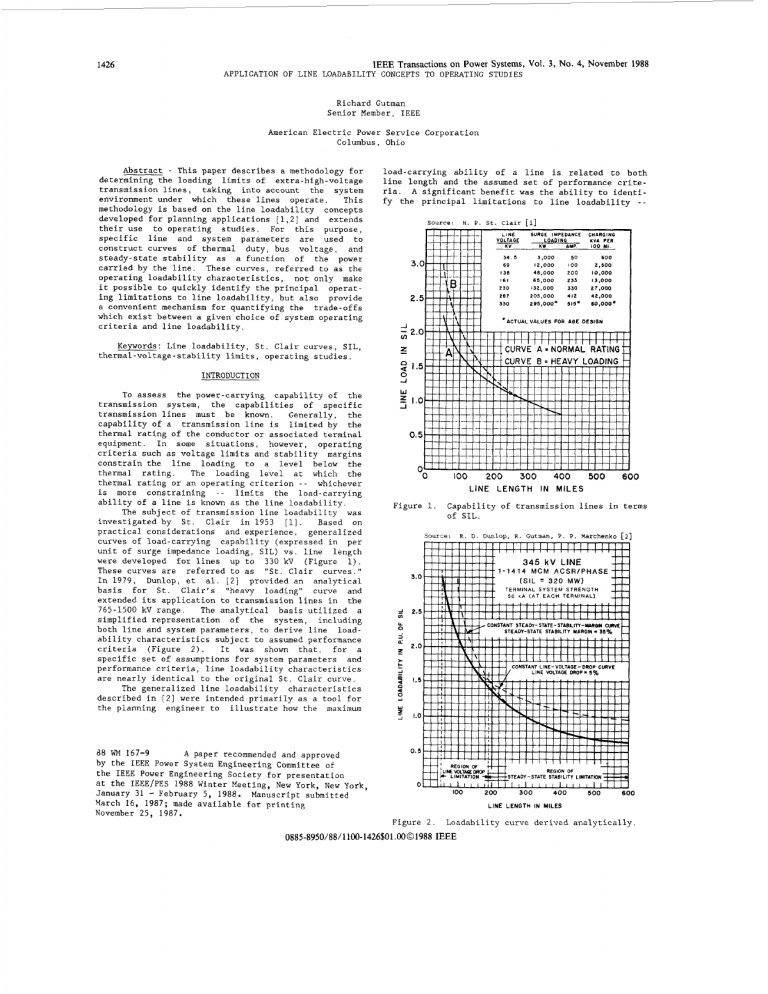
IEEE Transactions on Power Systems, Vol. 3, No. 4, November 1988
APPLICATION OF LINE LOADABILITY CONCEPTS TO OPEKATING STUDIES
1426
Richard Gutman
Senior Member, IEEE
American Electric Power Service Corporation
Columbus, Ohio
Abstract - This paper describes a methodology for
determining the loading limits of extra-high-voltage
transmission lines, taking into account the system
environment under which these lines operate. This
methodology is based on the line loadability concepts
developed for planning applications [1,2] and extends
their use to operating studies. For this purpose,
specific line and system parameters are used to
construct curves of thermal duty, bus voltage, and
steady-state stability as a function of the power
carried by the line. These curves, referred to as the
operating loadability characteristics, not only make
it possible to quickly identify the principal operating limitations to line loadability, but also provide
a convenient mechanism for quantifying the trade-offs
which exist between a given choice of system operating
criteria and line loadability.
load-carrying ability of a line is related to both
line length and the assumed set of performance criteria. A significant benefit was the ability to identify the principal limitations to line loadability - H. P. st. clair
source:
LINE
VOLTAGE
KV
34,s
3.0
69
138
161
230
zer
2.5
3>0
[I]
SURGE IMPEDANCE
LOADING
KW
AMP
50
100
200
233
3.000
12,000
48,000
65,000
132.000
205,000
295,000'
CHARGING
KVA PER
100 MI
600
2,500
330
10,000
13,000
27.000
412
42.000
515'
60.000*
Keywords: Line loadability, St. Clair curves, SIL,
thermal-voltage-stability limits, operating studies.
INTRODUCTION
To assess the power-carrying capability of the
transmission system, the capabilities of specific
transmission lines must be known. Generally, the
capability of a transmission line is limited by the
thermal rating of the conductor or associated terminal
equipment. In some situations, however, operating
criteria such as voltage limits and stability margins
constrain the line loading to a level below the
thermal rating. The loading level at which the
thermal rating or an operating criterion - - whichever
is more constraining - - limits the load-carrying
ability of a line is known as the line loadability.
The subject of transmission line loadability was
investigated by St. Clair in 1953 [l]. Based on
practical considerations and experience, generalized
curves of load-carrying capability (expressed in per
unit of surge impedance loading, SIL) vs. line length
were developed for lines up to 330 kV (Figure 1 ) .
These curves are referred to as "St. Clair curves."
In 1979, Dunlop, et al. [ Z ] provided an analytical
basis for St. Clair's "heavy loading" curve and
extended its application to transmission lines in the
765-1500 kV range.
The analytical basis utilized a
simplified representation of the system, including
both line and system parameters, to derive line loadability characteristics subject to assumed performance
criteria (Figure 2).
It was shown that, for a
specific set of assumptions for system parameters and
performance criteria, line loadability characteristics
are nearly identical to the original St. Clair curve.
The generalized line loadability characteristics
described in [2] were intended primarily as a tool for
the planning engineer to illustrate how the maximum
88 WM 167-9
A paper recommended and approved
by the IEEE Power System Engineering Committee of
the IEEE Power Engineering Society for presentation
at t h e IEEE/PES 1988 Winter Meeting, New York, New York,
February 5, 1988. Manuscript submitted
January 3 1
March 16, 1987; made available for printing
November 25, 1987.
-
-0
100
200
300
400
500
LINE LENGTH IN MILES
600
Figure 1. Capability of transmission lines in terms
of SIL.
Source:
R . D. Dunlop, R. Gutman, P . P. Marchenko [ 2 ]
1 - 1 4 1 4 MCM ACSRlPHASE
(SIL
320 MWJ
TERMINAL SYSTEM STRENGTH
5 0 % A AT E A C H T E R M I N A L
100
200
300
400
500
600
LINE LENGTH IN MILES
Figure 2. Loadability curve derived analytically.
0885-8950/88/1100-1426$01.0001988 IEEE
1427
i.e., thermal limitation for relatively short lines,
voltage drop limitation for medium-length lines, and
steady-state stability limitation for long lines.
As helpful as these loadability characteristics
have been in planning applications, they are not well
suited for use with transmission lines which operate
in a system environment different from that assumed
for the generalized loadability characteristics. To
overcome this limitation, the loadability analysis
described in this paper is "customized" to reflect the
specific operating conditions for a given line. The
result is a set of operating loadability characteristics, which provide a better understanding of, and a
comparative measurement of, the overall transmission
limitations to power transfer across lines or system
interfaces.
the following modifications:
o
the use of specific line configuration, line
length, and shunt reactor compensation for
each line studied;
o
the use of specific system strength at each
terminal of the line based on known system
conditions;
o
the effect of voltage regulation, if any, at
the line terminals;
o
the effect of transmission paths parallel to
the line under study;
the effects of critical system contingencies
which, by increasing the line flow and
reducing the system strength, bring the
:
loading of the line closer to the loading
In establishing the analytical basis for the
limit.
St. Clair curve, Dunlop, et al. [ 2 ] used a simplified
In the modified model, shown in Figure 4, the
system model which included an equivalent-Il representransmission line is represented by an equivalent-lI
tation for a transmission line of variable length.
with the terminal systems modeled as Thevenin equivaThe sending- and receiving-end systems to which the
lents. The transmission line equivalent is comprised
line was connected were represented as positiveof positive-sequence inductive and capacitive paramsequence Thevenin equivalents.
To replicate St. Clair's "heavy loading" curve, a
eters associated with the specific line of interest.
Shunt compensation that is physically located on the
mature (50 kA fault duty) system at each end of the
line was assumed. Other key assumptions involved the
line is combined with the line charging at the approperformance criteria imposed upon the model. Specifpriate line terminal.
The Thevenin equivalent
ically, a 5% voltage drop across the line and a 35%
reactances are determined from the short circuit
strengths of the sending- and receiving-end systems.
stability margin were considered. By varying these
criteria, the loadability of a line can be changed.
Making the criteria more restrictive (i.e., decreasing
the allowable voltage drop or increasing the required
stability margin) can improve system reliability, but
will generally result in a reduced loadability of the
transmission line.
In actual system operation, system parameters and
performance criteria can vary depending on where in
the system the transmission line is located and how it
is operated. Through variations in system strength,
performance criteria, and line length, specific
scenarios can be formulated showing that the loadability of a line can be significantly lower than its
Thus, to obtain a
thermal capability (Figure 3 ) .
measure of practical capability of a line, the loadability analysis must be customized to reflect the
operating conditions for each transmission line.
o
t
- - - -
THERMAL R h T I N G
REDUCTION IN CAPABILITY
LOADABILITY CURVE
I
L
LIWE LOADABILITY = P~ inw
Figure 4. Model for line loadability analysis.
c
LINE LENGTH
Figure 3 .
'E:
Reduction in line capability due
to limitations imposed by system
performance criteria.
Model Construction
To customize the loadability analysis, a model
for evaluating the loadability of specific transmission lines was developed. This model is similar to
the generalized model discussed in [2], but includes
The voltages behind the Thevenin equivalent
reactances are held fixed at values determined for a
particular system state, i.e., "base flow" condition.
The Thevenin equivalent voltages are determined by
reflecting the bus voltage and real/reactive power
flow (base flow) at the line terminals through the
Thevenin equivalent reactances.
The system state
selected represents a heavy loading condition consistent with the line loadability determination. This
requires the use of a peak load system condition, with
both contracted and expected economy sales, to obtain
a high base flow level. This base flow serves as the
starting condition for the line loadability analysis.
1428
Suecial Features
The model has the ability to account explicitly
for voltage regulation at either or both terminals o f
the line. This feature is particularly useful for
transmission outlets from the generating plants.
Voltage regulation in the model i s represented by
variable reactive support at the regulated bus, with
the maximum support equal to the reactive capability
of the regulating device. The effect of voltage
regulation on line loadability is illustrated in
Figure 5. Up to the limit of reactive support, QMax '
the bus voltage is maintained at a fixed level equal
to the scheduled voltage of the regulating device.
After that point, the bus voltage declines at an
increasing rate until it reaches a "critical value,"
set by the steady-state stability limit of the system,
beyond which no further increases in steady-state line
loading are physically possible. Voltage regulation
helps to support the bus voltage as the loading level
increases, resulting in higher (and more realistic)
line loading limits. Accurate modeling of voltage
regulation is especially important for lines which are
susceptible to low voltages during heavy loading
conditions.
1
115,
In the context of an interconnected power system,
the transmission system surrounding the line of
interest forms a parallel path for the power flow.
This aspect of the system is represented in the model
by an equivalent reactance in parallel with the line
under study (Figure 6). The presence of the parallel
path increases the total amount of power that can be
transferred from the sending end to the receiving end
of the line by lowering the effective reactance
between the two terminals. However, for a given
angular displacement across the system
(e St m ) '
which is related to the desired margin of stea8y-sfate
stability, the loading on the line will decrease due
to the sharing of power flow between the line and the
parallel path.
An important consideration in developing the
operating loadability characteristics is the effect of
system contingencies. Typically, systems are planned
and operated on the basis of at least a single contingency.
Consequently, high or critical facility
loadings will generally occur while another facility
is out of service. This suggests that the assessment
of line loadability should also include the effect of
critical contingencies in order to maximize the flow
on the line and/or to reduce the strength or reactive
support of the terminal systems. In this way, the
conditions under which the line loadability is of
greatest interest will be captured in the analysis.
An added benefit of including the contingency effect
in the model is that higher initial loading levels
(i.e., base flows) will result. Since the model is an
approximation, the closer the base flow level is to
the prospective line loadability, the more accurate
are the results.
OPERATING LOADABILITY CHARACTERISTICS
Derivation of Curves
*LINE F L O W ( M W )
Operating loadability characteristics, as distinguished from the generalized characteristics developed
by St. Clair, reflect the specific system conditions
under which a given line operates. An analytical
procedure to develop the operating loadability characteristics is summarized in Figure 7. Three types of
data are required for the analysis: line parameters,
system parameters, and operating parameters.
Figure 5. Effect of voltage regulation on line
loadability.
i n g Pardmeter*
-
LOADABILITY CHARRCTERISTICS
c7
W
0
o Thermal 3,ty C U I V ~
0 BUS Voltale curve
0 S t a b i l i t y ~ a r g i ncurve
I
w
U
2
U
w
t
<
U
-I
3
U
z
U
'LINE
FLOW ( M W )
Figure 6. Effect of parallel transmission path
on line loadability.
Figure 7. Analytical procedure for determining line
loadability.
1429
The line parameters include the positive-sequence
resistance (R), reactance (X), and the sending- and
receiving-end admittances (Y and Y ) . The effect of
shunt compensation is incluSdad wit% the line admittances. These values are specific for each line and
generally do not change over time.
The system parameters used in the model describe
the Thevenin equivalent impedances at the line termiand .the equivalent parallel path
nals (X and
impedade
?)These
values are obtained from short
circuit analyses which reduce the system surrounding
the line to a two-point equivalent to be connected at
the line terminals. The equivalent system parameters
are sehsitive to system configuration and change with
both time and system location.
The operating parameters are the Thevenin equivalent voltages (E and E ) behind the sending- and
receiving-end sysiems. &eBe
parameters are calculated from a solved ac load flow case which is used as
the base flow condition for the loadability analysis.
(5)
The Thevenin equivalent voltages are calculated by
reflecting the bus voltage at each line terminal back
through the Thevenin equivalent impedance.
The
Thevenin equivalent voltages influence the bus voltages and reactive power flows in the model and are
sensitive to major changes in system configuration
and/or operating condition.
When all line, System, and operating parameters
are combined in the loadability model, they uniquely
describe a specific transmission line in a specific
system location under specific operating conditions.
The loadability model can then be used to simulate
power flows - - higher or lower than the base flow
level - - and their effects on bus voltages and system
stability. The simulation results are used to generate a set of three curves that comprise the operating
loadabflity characteristics (Figure 8). These curves
describe the changes in thermal duty, bus voltage, and
system angular displacement as a function of the real
power (MW) flow on the line.
TRANSMISSION LINE LOADABILITY
LINE:
CAVIN
-
WSVILLE
-
LOADABILITY 3360 MW
(Stability limited)
GAVIN
t
755m
MARYSVILLE
124.3 Miles
16,700 MVA
SYSTW CONDITION: 1986 Summer
CONTINGENCY:-er
765 kV Line
IZmARKs:
,
Figure 8 .
Transmission line loadability characteristics.
GAVIN
1430
The thermal duty curve illustrates the relationship between the required thermal capability, expressed in MVA, and a given MW line flow. The thermal
duty is defined as the line current times the nominal
line voltage. There are actually two thermal duty
curves, one for each terminal of the line, taking into
account the generally different real and reactive
flows at the two line terminals. These differences
are relatively small, however, and the two curves are
essentially identical. The thermal duty curve is
practically linear over most of its length, except in
the heavy loading region, where the slope increases
more rapidly due to declining bus voltages.
The bus voltage curve describes voltage performance at each terminal of the line as a function of
the line flow. Generally, the receiving end of the
line exhibits a greater voltage decline than the
sending end, thus limiting the amount of power that
the line can carry. In Figure 8 (middle curve), the
Gavin bus voltage is regulated by the Gavin Plant for
line loadings up to about 2600 MW - - hence, the flat
voltage profile for this range of line flows. Once
the limit of regulation is reached, further increases
in line flow result in progressively larger bus
voltage depressions, leading to a phenomenon commonly
known as the "voltage collapse." While significant in
terms of its system consequences, voltage collapse is
only a symptom of a more fundamental problem, i.e.,
operation or attempted operation beyond the steadystate stability limit o f the system. This suggests
that the use of reactive support on the system, either
fixed or controllable, can move the system closer to
its steady-state stability limit.
The angular displacement curve shows the phase
angle difference across the line terminals ((3
) and
across the complete system model ('System Lfneas a
and 0
function of the line flow. The 'sptem
curves are similar
when the sys em reactancki?g
negligible relative to the line reactance (e.g., when
a long transmission line connects two strong systems).
In general,
is significantly greater than
eLine and, therSd'ijotr, only 0 Stem should be used in
assessing the system steadystate stability. System
stability is usually measured in terms o f the available stability margin, which is defined as the margin
between the maximum possible power flow (Pmax) and a
given power flow (Pgiven) expressed in percent of P
max
(Figure 9).
?o
( 'max
P
1
-
- 'given
max
Sin 0
Emergency thermal rating of a line or
associated terminal equipment, whichever is
lower. The emergency rating, rather than
normal rating, is used assuming that sufficient time will exist following a contingency to reduce the line flow to a level below
the normal rating.
Minimum acceptable bus voltage of 90% at
each end of the line.
Steady-state stability margin of 20%. This
margin is in addition to the critical
contingency considered in line loadability
calculations and, therefore, is not directly
comparable to the 3 0 - 3 5 % margin inherent in
the St. Clair curves (which did not consider
the contingency effects).
The latter two criteria reflect the desired level
of operating reliability and should not be viewed as
rigid limits. These criteria make it possible to set
the maximum loading limits based on acceptable transmission system stress, as determined from the loadability characteristics. Since these criteria relate
only to the steady-state conditions on the system, and
do not indicate whether the system can or cannot reach
a new steady-state condition following a disturbance,
the line loadability analysis should not be treated as
a substitute for comprehensive dynamic studies.
The loadability rating for a line is determined
as the highest real power (MW) which the line can
carry and still satisfy all of the established performance criteria. In Figure 8 , for the Gavin-Marysville
7 6 5 kV line, this loading level is 3360 MW as limited
by the 20% stability margin. Note that the line
thermal rating (4571 MVA) and the minimum bus voltage
criterion ( g o % ) , taken individually, allow higher
loading levels ( 3 8 9 0 MW and 3 6 6 0 MW, respectively),
but in both cases the steady-state stability margin
would be less than the desired margin of 20%. If a
smaller stability margin, say l o % , were considered
adequate, a line loading of 3780 MW would be possible,
assuming that the minimum bus voltage criterion could
also be relaxed to 88%. In this manner, the three
curves in Figure 8 can be used to quantify the tradeoffs which exist between a given choice of operating
criteria and line loadability.
It is important to remember that the loadability
ratings - - unlike the thermal ratings - - are unidirectional and must be recomputed when the direction of
the power flow is reversed. In practice, however,
those lines which experience the power flow reversal
are usually lightly loaded, and thus, accurate knowledge of the loadability rating for those lines is not
essential.
System
Verification
Ir
0'
30'
60'
90'
120'
150" 180'
TOTAL SYSTEM ANGULAR DISPLACEMENT (0
System'
Figure 9. Steady-state stability margin.
Performance Criteria and Line Loadability
Each of the three curves, shown in Figure 8 ,
addresses a possible limiting factor to transmission
line loadability. When used in conjunction with a
given set of performance criteria, these curves serve
to establish a single-valued loadability rating for
the line. The loadability rating incorporates the
following three performance criteria:
A rigorous ac load flow analysis of the interconnected system performance was used to verify the
accuracy of the operating loadability characteristics.
For this verification, the bus voltages and angular
displacement across the line (QLine) were selected.
The choice of these quantities was based on their
sensitivity to the power flow, especially at heavy
is
loading, A l s o , QLine was selected because 0
not available from the ac load flow analy?&?st.em It
(not QLine)
should be noted, however, that Q
provides a measure of system stabil??9Fem
For the verification of the loadability characteristics, a long (148.2 miles) 3 4 5 kV line, Amos-Matt
Funk, was used to amplify potential differences
between the line loadability analysis and the ac load
flow analysis. A s shown in Figure 10, the bus voltage
curves from the loadability analysis (solid lines)
1431
track well those obtained from the rigorous ac load
flow analysis (dashed lines).
A similarly close
comparison is evident between the
curves using
the two approaches. This is particukiany true in the
region near the base flow level, underscorine the need
to use a base flow level as close as possible to the
prospective line loadability.
TRANSMISSION LINE LOADABILITY
m:
MM
M I
. IUTT NWK
tun
LOAMBlLITY 830 HU
I
I
1u.z
nil..
I
14,000 WA
*
FUNK
I
5,200 M I A
103 nw
LINE FLOW I"*)
,
Minimum V o l t d g e
role in operating/planning studies.
Loadability
analysis is particularly well suited for assessing the
effects of system changes and for identifying limiting
factors to transmission system operation.
Both
features are necessary to develop effective plans for
increasing transmission loadability.
The initial step in loadability enhancement
studies is the identification of the existing transmission limitations. This is facilitated by the
operating loadability characteristics, i.e., thermal
duty, bub voltage, and system stability curves. From
these curves, the existing limitations can be identified and their severity measured in terms of the
impact on line loadability. Concentrating any system
imp$ovements on the most restrictive limitation will
yield the greatest improvement in line loadability.
The magnitude of the potential loadability improvement
is assessed by comparing the limitations from each of
the three curves. If one limitation is significantly
more constraining than the other two, the loadability
of a line can best be improved by addressing the most
constraining limitation. This could entail upgrading
the existing transmission facilities to improve
thermal capability; or installing reactive correction
to increase voltage support; or strengthening the
system to improve steady-state stability. If the most
constraining limitation is close to the other two
limitations, a more complex solution may have to be
developed.
When a plan or several alternative plans for
improving the loadability of a line have been developed, new operating loadability characteristics can be
derived to show the relative effectiveness of each
plan. If the number of plans is large, the new
characteristics can be used to identify the most
promising plans before the rigorous load flow and
dynamic stability studies are conducted. Similarly,
the loadability analysis provides a means to optimize
a particular system improvement plan.
seasonal System ADDraiSalS
Figure 10. Line loadability analysis vs. rigorous ac
load flow analysis.
In general, the line loadability analysis will
produce somewhat more optimistic results (i.e., higher
line loadability) than the rigorous ac load flow
analysis. This is because the Thevenin equivalents
used in the loadability model are assumed static over
a wide range of line loading levels. While yielding
accurate results close to the base flow level, this
assumption may not be acceptable at higher or lower
line loadings. In such situations, it may be desirable to establish two or more base flow levels to
improve the accuracy of the line loadability analysis.
It should be kept in mind, however, that getting the
additional base flow levels will require more ac load
flow solutions of the interconnected network that may
pose difficult convergence problems, particularly at
heavy line loading conditions.
-
A
q-
Line loadability concepts can play an important
To determine if sufficient levels of reliability
ar.e being maintained on the system, extensive studies
are conducted to appraise the performance of the
system. These studies, which are typically conducted
on a seasonal basis using large interregional network
models, rely on linear load flow analyses,to screen
transmission system capabilities and to identify
potential thermal limitations during transfer and,
outage conditions. Guided by these linear load flow
analyses, ac load flow studies are carried out to
assess the potential problems in detail. In addition
to the thermal loading problems, both voltage and
steady-state stability conditions are considered in
the ac load flow studies.
Since the seasonal system performance appraisals
are conducted using large network models, the effectiveness of the screening process in identifying
system limitations, regardless of their nature, is an
important consideration. By taking into account the
voltage and stability constraints under which the
transmission lines operate, the effectiveness of the
screening process can be enhanced. This added information, in conjunction with the thermal limitation,
can serve as a composite line rating for use in the
linear load flow analysis. The composite line rating
can be determined from the loadability characteristics
presented in this paper.
Using the loadability
ratings in the linear load flow analysis will make it
possible to screen out potential voltage and steadystate stability problems prior to the ac load flow
analysis. The benefit of this approach would be to
enhance both the effectiveness and efficiency of the
computer studies conducted as part of the seasonal
system performance appraisals.
1432
CONCLUSION
Transmission line loadability has been a useful
concept for the planning engineer in assessing the
loading limits - - expressed in terms of surge impedance loading - - for transmission lines of various
lengths and voltage classes. Although helpful in
planning applications, the generalized loadability
characteristics introduced by St. Clair are not well
suited for use with specific transmission lines which
operate under a wide variety of system conditions.
For application to operating studies, where the
specific system conditions must be taken into account,
line loadability calculations can be customized to
provide a set of operating loadability characteristics. These characteristics illustrate the effect of
the line flow on the thermal duty, bus voltages, and
steady-state stability for the line. Each of these
characteristics addresses a possible limiting factor
to transmission line loadability.
When used in
conjunction with a given set of performance criteria,
these characteristics can serve to establish line
loading limits which fully recognize the inherent
system capabilities.
While the line loadability
analysis presented in this paper cannot be viewed as a
substitute for detailed system studies, the results
obtained therefrom can be used to enhance the operation of the transmission system while maintaining the
desired level of system reliability.
REFERENCES
[l] H. P. St. Clair, “Practical Concepts in Capability and Performance of Transmission Lines,” AIEE
Transactions on Power Apparatus and Systems, Vol.
72, Part 111, pp. 1152-1157, December 1953.
[2] R. D. Dunlop, R. Gutman, P. P. Marchenko, “Analytical Development of Loadability Characteristics for EHV and UHV Transmission Lines,“ IEEE
Transactions on Power Apparatus and Systems, Vol.
PAS-98, No. 2, pp. 606-617, March/April 1979.
Clair (1) was useful at a time when a high voltage (138kV) transmission
circuit was used to interconnect two areas that were otherwise weakly
coupled (high parallel impedance) and where the line impedance alone
dominated voltage regulation and stability limits. The update to St. Clair’s
work (2) simply recognized that in EHV and UHV circuits of today the
effects of the terminating systems and shunt reactors could not be ignored. It
was also acknowledged that applications were practically limited to
situations where EHV and UHV circuits would be applied in point-to-point
transmission associated with remote power plants or interties with very
weak parallel paths. The author has taken an important step in recognizing
that EHV and UHV transmission circuits are very often part of a strong
“network”.
I would appreciate the author’s comments on some questions related to
the application and interpretation of line loadability characteristics with the
enhanced model discussed in the paper. First, with regard to voltage
regulation effects (Figures 5 and 8), it would seem likely that EHVIUHV
transmission circuits (in this case 765kV lines) that do not have generating
stations near their terminals could still be strongly influenced by voltage
regulation due to the electrical proximity of generating stations connected to
the high voltage (765kV) network. Would the author propose to ignore this
and accept a conservative result or have you considered running additional
load flows around the base condition to provide a more accurate reflection
of voltage regulation capability at the terminals of the line being studied?
With regard to stability, the author seems to imply that stability margins
and limits (Figure 9) are of the steady-state variety, Since the Thevenin
equivalent reactances are derived from short circuit studies where machines
are typically represented by their transient and/or subtransient reactances, it
would seem that the stability limits and margins are more properly
interpreted as “transient” stability based on an assumption that the system
behaves dynamically as an equivalent two-machine system. Also, would the
author please comment on the validity of a two-machine model for
calculating stability performance in a highly integrated multi-machine
system such as AEP; i.e., would one expect to achieve conservative results
compared with large-scale multi-machine model of thes ystem?
Finally, it would seem that the line loadability methodology would
provide a useful screening tool to identify the basis for loadability
limitations before conducting more detailed studies related to remedial
measures designed to enhance stability or avoid voltage collapse. It would
also seem that the model and methodology proposed by the author could be
adapted to on-line assessment of line loadability where actual system
conditions could be reflected in revised characteristics that would be
computed mostly from off-line information.
Manuscript received February 12, 1988.
Richard Gutman (M’77-SMI84) was born July 8 ,
1948. He received the B.S.E.E. (Magna Cum Laude) and
M.S.E.E. degrees from the Polytechnic Institute of New
York, New York, and the M.B.A. degree (with Weidler
Scholar Distinction) from The Ohio State University,
Columbus, Ohio. He also completed a course in Electric Power Systems Engineering by Power Technologies, Inc., Schenectady, New York, and the AEP/OSU
Management Development Program at The Ohio State
University.
Since 1968, he has been employed by American
Electric Power Service Corporation, Columbus, Ohio,
where he presently holds the position of Manager,
Special Transmission Studies Section in the Bulk
Transmission Planning Division. His responsibilities
include analytical studies related to the performance
of transmission systems, plant/system voltage coordination, application of static var systems, line loadability assessment, ground wire selection, breaker duty
evaluation, and three-phase system modeling and
unbalance analyses.
Mr. Gutman is a member of Tau Beta Pi, Phi Kappa
Phi, and Beta Gamma Sigma honor societies, and is a
Registered Professional Engineer in the States of Ohio
and New York.
Discussion
Raymond D. Dunlop (New England Power Service Co., Westborough,
MA): The author is to be. congratulated for taking the concept of line
loadability a step closer to practical application. The earlier work by St.
RICHARD CUTMAN: The author would like to thank
Dr. Dunlop for his comments and interest in the paper.
D r . Dunlop raises an interesting question with regard
to voltage regulation effects of generating stations
located in the electrical proximity of the line being
studied. In the paper, only those stations located at
the line terminals are explicitly represented in the
loadability model. The effects of other stations are
included in the Thevenin equivalents ( E /X and E /%)
derived from load flow and short circuik Snformagion.
This was a judgemental choice of the author based on
the following factors. First, a key objective was the
simplicity and ease of
use of the
loadability
technique. Since the technique was designed primarily
as a screening tool, accurate modeling of reactive
sources located one or more buses away from the line
terminals was not considered essential. While it is
true that improved modeling would yield better
results, the associated complexity appeared difficult
to justify for the intended purpose. As an offsetting
factor, which also contributes to the simplicity of
the proposed technique, the Thevenin
equivalent
voltages E and E are assumed constant throughout the
loadabilit; calculation. The combined effect of these
two simplifying assumptions is to yield somewhat
optimistic results of line loadability as compared to
a more
rigorous approach.
This comparison
is
illustrated in Figure 10 in the paper.
It
is
noteworthy that, in addition to its simplicity and
reasonable
accuracy, the
loadability technique
provides important insights regarding steady-state
1433
stability limit to power transfers; this information
is generally difficult to obtain using conventional
load flow methods.
In reply to Dr. Dunlop's question regarding the
term "steady-state stability margin," the author would
like to expand upon a subtle aspect of line loadability determination. As stated in the paper, the
Thevenin equivalent reactances Xs and
as well as
the equivalent parallel
path reactance X , are
obtained from short circuit analyses which redgce the
system surrounding the line to a two-point equivalent
to be connected at the line terminals. In these short
circuit analyses, the generating units located in the
electrical proximity of the line being studied are
modeled by their respective synchronous reactances,
rather than the usual subtransient reactances. This
refinement can be significant keeping in mind the
roughly 1O:l ratio of the synchronous-to-subtransient
reactances for large generatiilg units connected to an
EHV network. The use of the synchronous reactances
s,
for generators is considered more consistent with the
steady-state nature of the loadability characteristics
presented in the paper. Follow-up studies would
normally be required to assess the transient and/or
dynamic system performance, including the adequacy of
the operating margin selected based on steady-state
stability considerations.
With regard
to on-line adaptation of
the
loadability technique, it would certainly represent a
major new application for
this tool.
Such an
adaptatioq could be a challenging task, however.
In
its present form
as a
two-machine model,
the
loadability toe1 is not well suited for on-line
applications because it does not capture the limitations (thermal, voltage or stability) that may exist
away from the line being studied. A careful study of
the tool design and its underlying assumptions would
be necessary to extend its use to on-line assessments
of line loadability.
ManusCripi received April 13. 1988.
